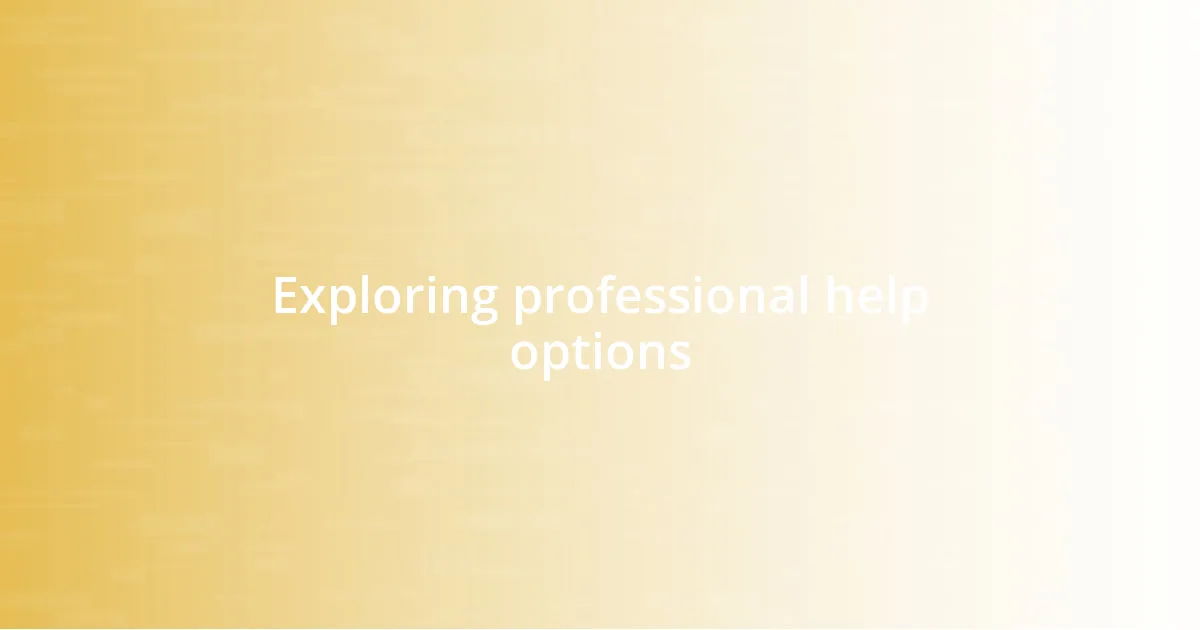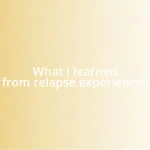Key takeaways:
- Anxiety during treatment often arises from fear of the unknown, leading to overthinking and panic.
- Identifying personal triggers for anxiety, such as specific environments or discussions, helps in managing feelings and creating a supportive space.
- Utilizing mindfulness techniques, like deep breathing and focusing on the present moment, can effectively reduce anxiety.
- Exploring professional help, including therapy and medication, offers a holistic approach to enhancing emotional well-being.

Understanding anxiety during treatment
Anxiety during treatment can feel like a shadow that looms over every step of the healing process. I remember sitting in the waiting room, my chest tightening as I heard my name called. What is it about the sterile scent of antiseptic and the sound of rustling paper gowns that makes our minds spiral into panic?
It’s important to recognize that anxiety often stems from the fear of the unknown. I often found myself overthinking every possible outcome, imagining the worst when, realistically, my situation was nowhere near as dire as I pictured. Have you ever caught yourself in a loop of “what if” scenarios? I certainly did, and it took conscious effort to pull myself back to reality, reminding myself that worrying wouldn’t change the outcome.
Finding ways to cope with that anxiety became essential for me. Journaling, for instance, became a refuge—a way to externalize my swirling thoughts. I would ask myself, “What’s one thing I can control in this moment?” Focusing on small actions made me feel empowered, even when everything else felt chaotic. It’s these little strategies that helped me navigate through the fog of anxiety and allowed me to reclaim my peace during treatment.

Identifying personal triggers for anxiety
Recognizing my personal triggers for anxiety was a crucial step in managing it during treatment. I distinctly recall one instance when the sound of medical machines set my heart racing. It took a few sessions to realize that those mechanical beeps reminded me of past experiences that were overwhelming. By identifying this trigger, I learned to incorporate grounding techniques, like deep breathing, whenever I encountered it.
Additionally, I kept a journal where I documented particular situations that heightened my anxiety. I noticed patterns—like specific environments or conversations that left me feeling rattled. For example, engaging in discussions about prognosis often sent me spinning into a whirlwind of worry. With this awareness, I could prepare myself in advance or even avoid certain topics, ultimately reducing my anxiety levels and creating a more supportive space for myself.
Sometimes, the most unexpected triggers emerge; something as simple as the smell of certain disinfectants could take me back to distressing moments. This exploration taught me that it’s not just about managing anxiety in the moment, but actively understanding what sparks it. This insight gives us the ability to take actions that prioritize our emotional well-being throughout the treatment journey.
| Common Triggers | Personal Reactions |
|---|---|
| Medical environments | Increased heart rate, panic |
| Talk of prognosis | Feeling overwhelmed, spiraling thoughts |
| Specific smells | Emotional distress, flashbacks |

Developing coping strategies for anxiety
Finding effective coping strategies for anxiety during treatment became a personal journey for me. One technique that resonated deeply was mindfulness. I can still picture myself sitting by the window, focusing on the patterns of light dancing through the leaves. This practice wasn’t just about calming my mind; it was about grounding myself in the present. Whenever anxious thoughts threatened to pull me under, I’d take a moment to breathe deeply, redirecting my focus to my surroundings.
Here are some coping strategies that worked for me:
- Mindfulness meditation: Engaging in simple meditation practices helped me gain control over racing thoughts.
- Physical activity: A brisk walk or some stretching provided an instant mood boost, releasing those feel-good endorphins.
- Creative outlets: Drawing or painting allowed me to express emotions that felt too heavy to articulate.
- Support networks: Having a trusted friend or family member to talk to about my feelings made a world of difference. Sometimes, just sharing my fears helped lighten the load.
- Positive affirmations: Repeating affirmations helped distract my mind from negativity and instilled a sense of calm.
I vividly remember a night when anxiety threatened to engulf me. Lying awake, I started jotting down my thoughts, releasing the pressure that had built up inside me. With each word, it felt as if I was shedding weight, transforming anxiety into something tangible I could confront. In that moment, I understood that coping strategies weren’t just about silencing anxiety; they were about giving it space and defining my own narrative in the midst of uncertainty.

Utilizing mindfulness techniques effectively
Utilizing mindfulness techniques transformed my approach to managing anxiety during treatment. I remember an afternoon when I felt overwhelmed by a surge of anxious thoughts. Instead of fighting them, I sat in a quiet corner and focused on my breath. I noticed how each inhale brought in calmness while each exhale released tension. It was like hitting a reset button; those few minutes of mindfulness created a refuge amidst the chaos.
Mindfulness isn’t just about sitting in silence; it’s about engaging fully with the present moment. One time, while having a cup of tea, I took a moment to really savor the experience. I focused on the warmth of the cup in my hands, the aroma wafting up, and the taste on my tongue. By immersing myself in such simple activities, I found a way to anchor myself, making those small moments feel less overwhelming and more like a source of comfort. Have you ever tried turning a mundane moment into a mindful one? It’s astonishing how even the smallest pleasures can shift your mindset.
I’ve learned that practicing mindfulness can also mean embracing discomfort, rather than running away from it. When anxiety crept in, I found myself acknowledging what I was feeling—like standing outside in a rainstorm without an umbrella. In those instances, I would verbalize my emotions, reminding myself that it’s okay to feel uneasy. This acceptance became a powerful way for me to cope, allowing anxiety to exist without letting it take over. Mindfulness taught me that the fabric of my experience could be both beautiful and chaotic, and that’s perfectly okay.

Exploring professional help options
Exploring professional help options was a pivotal step in my journey. I remember sitting in my therapist’s office for the first time, feeling both nervous and hopeful. Talking with someone trained to help made a significant difference. They listened without judgment and provided me with strategies that felt more tailored than any self-help book I’d read. Have you ever felt that instant connection with someone who just gets where you’re coming from? It can change everything.
Counseling opened doors for me. Through regular sessions, I started to unpack the layers of anxiety that had built up over time. I vividly recall a particular session where we explored cognitive-behavioral techniques. By altering my thought patterns, I learned to challenge the negativity that often flooded my mind. This wasn’t just about managing anxiety; it was about reshaping my entire outlook on challenges. Finding the right therapist is not always easy, but when it clicks, the growth can be profound.
Consulting with a psychiatrist also allowed me to explore medication options when needed. Initially, I was hesitant, concerned about reliance on pills. However, once I understood how medication could stabilize my mood and alleviate crushing anxiety, I felt a sense of liberation. I still remember the relief washing over me after starting a low-dose prescription. It became clear that professional help wasn’t just one-dimensional; it was a holistic approach that combined various avenues to enhance my well-being. What about you? Have you considered how a multi-faceted support system could be your key to managing anxiety?

Tracking progress and adjusting methods
Tracking my progress was a crucial aspect of managing my anxiety during treatment. I kept a daily journal where I recorded my moods, thoughts, and feelings. This practice wasn’t just about noting what went well but also about recognizing patterns in my anxiety triggers. Have you ever noticed certain events or situations making your anxiety spike? Journaling helped me identify these moments, allowing me to prepare for them with better coping strategies.
As time went on, I became comfortable adjusting my methods based on what my records revealed. For example, when I noticed that days filled with social interactions often led to increased anxiety, I began to plan quieter days afterward as a form of self-care. I remember vividly when I decided to take a “social detox” weekend after a particularly stressful week of gatherings. The difference in my mental state was striking; I felt revitalized and ready to re-engage. Reflecting on my experiences and changing my approach empowered me to take control of my anxiety journey.
Adapting my coping mechanisms also meant being open to new techniques that presented themselves along the way. One evening, a friend suggested trying guided imagery, and I decided to give it a shot. I vividly remember closing my eyes and imagining a serene beach, the sound of waves lapping against the shore. That moment transported me, allowing my anxious thoughts to dissolve into the gentle rhythm of the ocean. It amazed me how one small adjustment—trying something new—could have such a profound impact. How willing are you to experiment with fresh strategies in your own journey?















